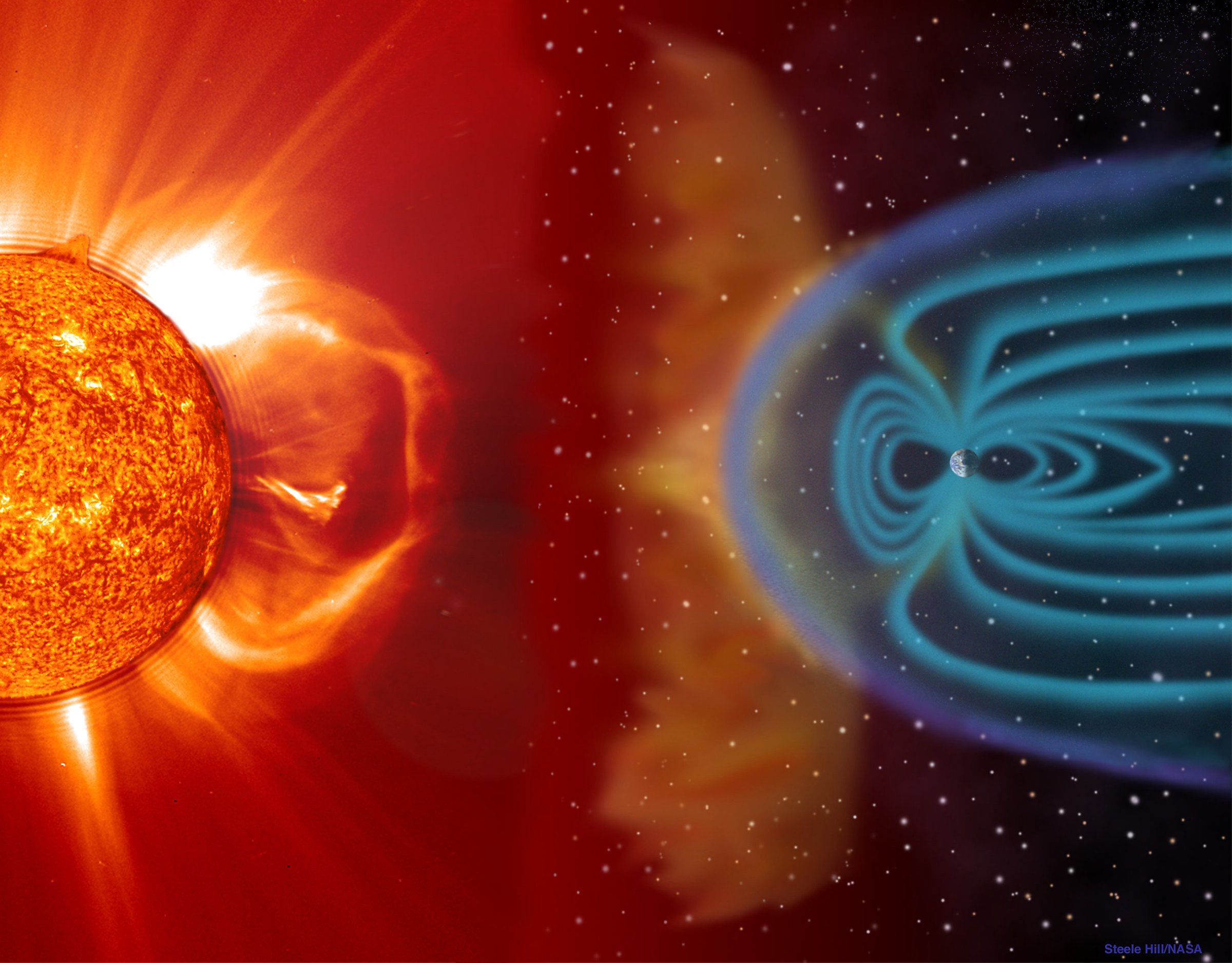
 Orion is proud to partner with BBC Sky at Night Magazine, the UK's biggest selling astronomy periodical, to bring you this article as part of an ongoing series to provide valuable content to our customers. Check back each month for exciting articles from renowned amateur astronomers, practical observing tutorials, and much more!
Orion is proud to partner with BBC Sky at Night Magazine, the UK's biggest selling astronomy periodical, to bring you this article as part of an ongoing series to provide valuable content to our customers. Check back each month for exciting articles from renowned amateur astronomers, practical observing tutorials, and much more!
The Magnetic Universe
Lucie Green takes a closer look at how magnetic fields have shaped the cosmos.

The Sun's magnetic field and the release of plasma directly affect Earth and the rest of the solar system. Solar wind shapes the Earth's magnetosphere and magnetic storms are illustrated here as approaching Earth. The white lines represent the solar wind; the purple line is the bow shock line; and the blue lines surrounding the Earth represent its protective magnetosphere. (Image and caption courtesy of NASA Image Gallery)
You can't see it, but it's there. All the time, and all around you. Protecting you from harmful space radiation and preventing our atmosphere from being stripped away by solar winds — it's the Earth's magnetic field.
For most of us, it hardly ever catches our attention. In observational astronomy, the Earth's magnetic poles are far less important than the geographic poles that we rely on to align our equatorially mounted telescopes. Consider this, though: the Earth's magnetic field probably made life on this planet possible, while more distant, cosmic magnetic fields are the reason that pulsars act like radio lighthouses and vast clouds of electrically conducting gas get sculpted into strange and unusual shapes.
As magnetic fields go, Earth's is the one we're most familiar with and its origin lies in the electric currents that flow in the molten iron that makes up our planet's outer core.
Planetary magnetism
Let's take a step back and look at Earth from the surface of the Moon. From here, we can see the land, oceans and atmosphere. What we can't see, however, is how the Earth's magnetic field envelops it all and extends out into space. For most of the time the Moon is inside the Earth's magnetic field. It only pops out for a few days around the time of new Moon. When it does, the Moon moves into the solar wind — the Sun's outer atmosphere that expands into space at a speed of a million miles an hour.
This wind can't penetrate Earth's magnetic field and instead slams straight into it. Although this interaction is invisible to the human eye, it does produce something spectacular: the aurora. As the solar wind pushes against Earth's magnetic field, it adds energy to it that accelerates charged particles down into our atmosphere. When the particles interact with atmospheric gas, they pass their energy on and cause the gas to glow.
The solar wind is blocked from reaching our atmosphere because it too contains a magnetic field. We've learned that any magnetic field that threads through an electrically charged gas (a plasma) is tied to that gas; they can't be easily separated, or decoupled, as the process is known. So when the gusty flow of magnetized plasma reaches the Earth's magnetic field, it flows around it, causing it to move and ripple like a windsock in a breeze. This property prevents the solar wind from reaching our atmosphere and stripping it away, as happened on Mars. It also provides us with protection from electrically charged cosmic rays.
This life-preserving property that planetary magnetic fields have means that it's important to consider them when it comes to studying exoplanets. So far, we're unable to directly observe an exoplanet's magnetic field. But should a technique for detecting them be developed in the future, the presence of a magnetic field around an exoplanet is likely to influence which ones become targets for further study.
The discovery of the Sun's magnetic field came in 1908 and was made by American astronomer George Ellery Hale. It's impossible to look for and study cosmic magnetic fields without the ability to detect them from a distance using electromagnetic radiation. In 1896, Dutch physicist Pieter Zeeman was carrying out experiments when he found that a strong magnetic field could affect the light given off by a "luminous vapor". The spectral lines emitted by the vapor were broadened or, in extreme cases, split into several components. In a paper published in 1897, Zeeman suggested that his discovery might be used to detect cosmic magnetic fields.
Indeed, it was this technique that was used by Hale to detect the magnetic field of sunspots. The Zeeman effect also polarizes the light in particular ways that can be used to understand the strength and direction of the distant magnetic field, allowing astronomers to probe distant magnetism by studying electromagnetic radiation.
In fact, the Sun allows us to investigate cosmic magnetism up close. Observations of the Sun provide a fantastic level of detail that really shows us how dynamic stellar magnetic fields can be. The Sun has an overall magnetic field that connects the north and south magnetic poles, which are close to the heliographic north and south poles, as they are on Earth.
Small-scale magnetism
But closer inspection of the solar atmosphere reveals arches of magnetic field connecting pairs of sunspots and twisted magnetic field structures known as flux ropes. These ropes are revealed because glowing, electrically charged gas traces them out, similar to the way iron filings sprinkled around a bar magnet align themselves to the field lines. If you watch the Sun over time you'll see that these magnetic structures are always changing and often erupt into the Solar System. The Sun's spatially resolved dynamic activity, powered by magnetism, gives us a glimpse of what other stars are also up to. And it's not just main sequence stars that have important magnetic fields.
Pulsars are a sub-set of neutron stars. Formed from the collapsed cores of high-mass stars that have undergone a supernova explosion, they spin extremely rapidly. As they spin, they flash out pulses of radio waves, as if they were cosmic lighthouses. Some of them flash many times a second. When Jocelyn Bell-Burnell discovered pulsars in 1967 they were viewed as curious objects and jokingly labelled LGM for Little Green Men. But the radio flashes can be understood if you combine a very rapidly spinning star with a strong magnetic field.
As a dying star collapses, its magnetic field is also drawn in with the material of the star itself, intensifying the field strength to a trillion times that of the Earth's. The presence of the field causes charged particles to gyrate around the magnetic field lines and when this happens, radio waves can be created. The radio signal will be concentrated at the north and south magnetic poles of the neutron star. The final ingredient in the making of a pulsar is to have an offset between the star's axis of rotation and the axis connecting the magnetic poles. This means that as the neutron star spins, the radio beam will sweep across space and our radio telescopes can detect it. In fact, neutron stars are record holders when it comes to magnetism: another sub-set of these stars harbor the strongest magnetic fields in the Universe, a thousand times stronger than that of the pulsars. These objects are rather unsurprisingly known as magnetars.
Galactic magnetism
The magnetic field of Earth and the magnetic field of the Sun, thanks to the solar wind, are not the only fields we find ourselves immersed in. Our Galaxy, the Milky Way, has a magnetic field too, albeit with a strength tens of thousands of times less than that of the Earth's. What the galactic field does have in common with the Earth, though, is that rotation is at the heart of its existence.
Magnetic fields in astrophysical objects are created by dynamos, a mechanism in which the rotation of an electrically conductive liquid (such as the molten iron in the core of a planet) is converted into magnetic energy. In this way, how fast an astronomical object spins is an important aspect of magnetic fields and dynamos.
In this context we can understand why Earth has a relatively strong field whereas Mars, once thought to be more Earth-like than it is today, doesn't. Inside Earth, the rotating molten shell means its dynamo is still acting. Mars, on the other hand, had a dynamo, but it ceased acting when the interior of this smaller planet cooled and solidified, leaving only a remnant of its magnetic field locked up in its rocks.
When it comes to timescales, stars and planets can take anything from hours to weeks to complete a single rotation. But these bodies have been around for so long that plenty of time has passed during their lifetimes to sustain and even evolve their magnetic fields. For example, the Sun rotates once every 27 days and has been around for 4.5 billion years. Assuming that the rotation rate has been constant during all of this time, the Sun could have spun over 60 billion times. This isn't the case when it comes to galaxies though. Take the Milky Way: our Galaxy rotates once every few hundred million years, which means there has only been time for it to make a few hundred rotations. So, while a dynamo is important for our Galaxy, there are other additional processes that are making an impact and which still need to be understood.
In 2017, a team led by scientists from the Max Planck Institute for Radio Astronomy in Germany published work showing that galaxy observations can be used to investigate magnetic fields when the Universe was much younger too. Their study of a galaxy that is nearly five billion lightyears away allows us to look back into the early Universe to study the history and evolution of magnetic fields, providing insight into a question that astronomers have long wanted to answer: how long have magnetic fields existed for?
Magnetic fields are magnificent and common across the cosmos. From planets and stars, to galaxies and beyond. Along with gravity, magnetism is responsible for shaping and controlling what we observe. So, next time you look up — no matter what you're looking at — remember the invisible force that is helping shape our Universe.
What are magnetic fields?
Magnetism is a force that is intimately related to electricity. Whenever an electric current flows there will be an associated magnetic field in the surrounding space, or more generally, the movement of any charged particle will produce a magnetic field. Try turning your kettle on and off and see if your smartphone's compass app can detect the magnetic field generated as the current runs through the cable.
These fields have a direction, which is why Earth has a north and a south pole. When two magnetic fields come close to each other, they will try to align, potentially causing the physical objects causing them to move — a compass needle has a magnetic field, and so will always try to line up with Earth's field and point north.
Similarly, the motion of a charged particle will change as it passes through a magnetized area, due to the interaction of the electric and magnetic fields. How the direction changes depends on the charge and mass of the particle, the strength and direction of magnetic field and how fast the particle is travelling.
ABOUT THE WRITER
Lucie is a Professor of Physics and a Royal Society University Research Fellow based at the Mullard Space Science Lab.
Copyright © Immediate Media. All rights reserved. No part of this article may be reproduced or transmitted in any form or by any means, electronic or mechanical without permission from the publisher.






 /
/ 






